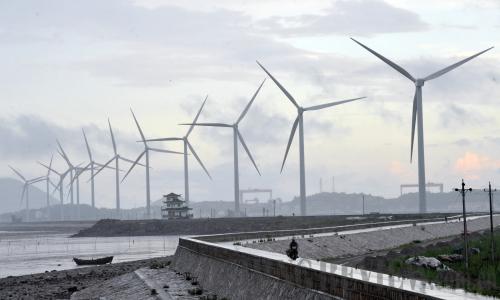|
 |
|
A CLEAN BREEZE: This picture shows the Donghaitang wind power project in Wenling, Zhejiang Province. Each of its 20 turbines can generate enough electricity for 2,000 households every year, while cutting carbon dioxide emissions by 80,000-100,000 tons (WANG DINGCHANG) |
China's National Development and Reform Commission publicized the country's policies and actions for addressing climate change in a report released on November 26, 2009. The report highlighted China's efforts in cutting greenhouse gas emissions in 2009 by:
(1) Rigorously checking the blind expansion of its energy- and pollution-intensive industries. The government strictly implemented its industrial policies and regulations on project administration, tightened its land use review, energy conservation evaluation and environmental impact assessments, rigidly controlled low-level repeated construction of energy and pollution-intensive industries, and continued to restrict the export of the energy-intensive, pollution-intensive and resource-based products. In 2009, the country also closed down or stopped small thermal power generation units of a total capacity of 15 gigawatts through "approving the large and discouraging the small," phased out backward production capacities of 10 million tons of iron, 6 million tons of steel and 50 million tons of cement, and perfected the mechanism for phasing out backward production capacities.
(2) Concentrating on and succeeding in major projects and key fields. The country increased its investment in major projects with public funds from the Central Government and local governments, and provided guidance for social investment. In 2009, it developed an energy conservation capacity of 75 million tons of coal equivalent through the projects, and had an additional urban wastewater treatment capacity of 10 million cubic meters daily and newly added facilities with a total capacity of more than 50 gigawatts for smoke desulfurization at coal-fired power plants. It also acted on promoting energy conservation at 1,000 enterprises, thus gaining an energy conservation capacity of 20 million tons of coal equivalent; improved the work of renovating 60 million square meters of existing buildings for energy conservation in the northern areas with heating provision; and encouraged the trade-in of cars and home appliances.
(3) Vigorously developing a circular economy. The country established a special fund for the development of a circular economy, and thereby supported the technology development and capacity building for and the demonstration and popularization of a circular economy. It sped up the construction of the resource-reclaiming system, continued to push forward the ban on plastic bag use and the integral utilization of straws, while dealing with the excessive packaging of commodities.
(4) Accelerating the popularization of high-efficiency and energy-conserving projects. The government implemented the "Program of Benefiting the People Through Energy-Efficient Products" to promote, via financial subsidies, high-efficiency and energy-conserving products in 10 categories, including air conditioners and refrigerators. The program also supported the launching of the pilot projects of energy-conserving and new-energy cars in 13 cities including Beijing, Shanghai and Chongqing; in addition to promoting 120 million energy-conserving lamps.
(5) Deepening reform and perfecting policies. The country implemented the scheme for reforming the prices and fees of oil products; perfected the price formation mechanism for natural gas and revised the catalogue of high-pollution and environmentally hazardous products. It further expanded the scale of corporate bond issuance for energy conservation and emissions reduction, and conducted a trial of sulfur dioxide emissions trading in regions with proper conditions. It also formulated measures for assessing and reviewing the energy conservation of fixed assets investments and regulations on the discharging and treatment of urban wastewater. In addition, it modified the administrative measures for energy conservation in major energy-consuming enterprises and the measures for the administration of energy efficiency labeling and continued to organize the formulation and modification of the mandatory national standards on the energy consumption limits for high-energy-consumption products and on the energy efficiency of various products.
(6) Tightening regulations over energy conservation and pollution reduction, while consolidating the target and responsibility system. The Central Government did this, in part, by publishing the results of performance assessments of provincial-level governments in fulfilling their responsibilities and attaining their 2008 targets for this work, delivering rewarding and punitive measures, intensifying supervision and inspection and further increasing the primary responsibility of the government for this effort.
(7) Stepping up capacity building. The country perfected the systems for the statistics, monitoring and assessment of energy conservation and pollution reduction. This was accompanied by a strengthening of personnel training for the technological support of this work.
(8) Actively participating in international cooperation. China substantially boosted bilateral, regional and multilateral cooperation on the research and development of energy conservation, new energy and low-carbon technologies.
(Source: www.ndrc.gov.cn) |
